Whether it’s smoke from the stove or a stench in the bathroom, your vent fan does a lot of work to keep the air nice and clear in your RV.
Whether it’s sucking air out or circulating it inside your RV, your vent fan is something you’lll be using all the time.
We’ve taken energy consumption and effectiveness into account, tested these ourselves, and now we’re left with a condensed, concentrated list of the very best vent fans on the market. Let’s show you the number one model first.
For The Best Ventilation, Take A Look At The Top Vent Fan Before Reading More
Fan-Tastic Vent 7350
Why is it better?
- Excellent rain sensor
- Infrared RC
- Reverse airflow
5 Best Vents For Your RV
With that in mind, let’s now take a closer look at our top picks.




Let’s dive into the specifics and review each vent individually. You can use the list below to jump and review specific models, or you can read along and go through all the information.
Best Overall: Fan-Tastic Vent 7350
Fan-Tastic is the number one brand on the market, hands-down.
There’s a lot to love about this model, so let’s just jump right into some of the killer features that make this the most operational and reliable Fan-Tastic RV fan on the market.
Key features include the excellent rain sensor, which closes automatically when rainfall begins, and the infrared remote control for hands-free operation.
This model also comes with reverse airflow to propel air inwards to gently cool off the interior of your cabin and switches back just as quickly.
The automatic lift gives you ease of use, while the three-way manual speeds allow you to cut down on energy consumption depending on the conditions.
We went directly to Fan-Tastic’s website, and still couldn’t find decisive information regarding the amperage use, only that it is “low.”
For a bit of transparency, there’s an odd fact about this vent fan.
It’s outfitted to work in 14×14” spots, though the product dimensions are actually 14×13”. Based on other RV drivers and their experiences, they said there’s no problem fitting it into the 14×14” slot, but it still leaves us wondering a little.
While the IR remote is convenient, you do have to be at a specific angle in order for it to work. We would have loved to see a more powerful remote that didn’t remind us of television sets from 1995, but at the end of the day, the remote control is a minor feature and doesn’t impede upon the practicality and reliability of this model.
All in all, this Fan-Tastic RV fan claimed the number one spot for the immeasurable benefits and reliability that you receive for the price.
These are simple to install and keep you in check with the rain detector, taking error out of the equation.
PROS
- Excellent rain sensor
- Infrared RC
- Reverse airflow
CONS
- IR remote is not precise
PRODUCT INFORMATION
- Dimensions: 14x14x12”
- Amperage: Low Amperage ( Defined by manufacturer )
- CFM: Not specified by the manufacturer
- Lift Style: Automatic
- Rain Sensor: Yes; auto close when raining
- Reverse Airflow: Yes
- Remote Control: IR Remote
- Thermostat: Yes
- Variable Speed: 3 Manual Speeds
- Warranty: Warranty specifics located here
Maxxair 0007000K
The two biggest names in RV vent fans are here, and Maxxair came in a very close second.
For our runner-up, you get excellent features with a relatively low cost, and a perk over the top pick from Fan-Tastic, as well.
You get ten speeds for your fan, which gives you optimal control over energy consumption, as well as your comfort level.
If you’ve never been able to find the sweet spot in between two settings for your Maxxair RV fan , this is the ticket. 900 CFM gives you absolute dominance over your vent fan.
Amperage use is fairly low considering the varying fan speeds. One thing this model doesn’t have is a rain sensor, though it does have a rain shield.
Either way, you’ll be held responsible for ensuring that the hatch is closed during the rainy season.
We were a little disappointed to find that there’s so much crypticism behind the warranty information. You have to contact customer service, and even then, the warranty is only for parts.
It has us wondering if their customer service is even a viable option, should you need them.
You don’t get reverse airflow, but you do get an ultra-precise thermostat, which can be controlled via the remote. This fits all standard 14×14” openings, regardless of your RV make/model.
Maxxair always provides durability, which is why, regardless of the sketchy warranty bits, this still holds its spot at #2 on our list.
PROS
- Low cost when compared to other products on market
- 900 CFM
- Ten variable fan speed settings
CONS
- Unclear warranty information
PRODUCT INFORMATION
- Dimensions: 26×21.5×16.6” (Fits standard 14×14” openings)
- Amperage: 3 amps per hour on the highest setting
- CFM: 900
- Lift Style: Automatic
- Rain Sensor: Rain shield, not the sensor
- Reverse Airflow: No
- Remote Control: Yes
- Thermostat: Yes
- Variable Speed: 10 Speeds
- Warranty: Warranty information can be requested from customer service; parts only
Maxxair 00-04000K
For the minimalist budget with the most benefits you could receive for your dollar bill, there’s this excellent Maxxair RV fan to perfectly balance out your desires and your funding.
You get a lot of similar features to higher-grade models, while still boasting the ability to drop this into any 14×14” spot on any RV.
Energy efficiency is something you want to take care of once, and not have to think about again.
With low amperage, this unit hits its mark on energy consumption. For an inexpensive model, they really went all-out on the remote control for this one.
It’s used brilliantly to control the thermostat from a distance, though it can be exceedingly difficult to use from the driver’s seat (not that you should be using the remote while operating the RV anyway, but it’s still something to point out).
Quiet operation via the brushless motor makes this a friend of the light sleeper, as well.
One complain that’s similar to the previous model is Maxxair’s lack of warranty details prior to purchasing the product, having them only be available through contacting customer service.
Other than that and the lack of rain shield/sensor, this model is excellent for budgeters who refuse to compromise on quality. Seamless installation and the CFM power of higher-grade models makes this a steal.
PROS
- Low energy consumption
- Quiet operation
- Remote control of thermostat
CONS
- Lack of warranty details prior to purchasing the product
PRODUCT INFORMATION
- Dimensions: 17.4×17.2×10”
- Amperage: Low Amperage
- CFM: 900
- Lift Style: Manual
- Rain Sensor: Not Available
- Reverse Airflow: Not Available
- Remote Control: Yes
- Thermostat: Yes
- Variable Speed: Yes, though amount not specified by the manufacturer
- Warranty: Warranty information can be requested from customer service; parts/labor
Fan-Tastic Vent 801200
We’re considering this one an honorable mention – we couldn’t get away without mentioning this stellar Fan-Tastic RV fan .
Crafted primarily of ABS plastic on the namesake smoke dome, this model gives you terrific coverage and durability.
ABS plastic is the same material used to make LEGOs and is also used in certain vehicle body manufacturing.
It’s built to last.
While you’ll be cutting back on a remote control, rain sensor/shield, and the thermostat only comes in upgraded versions of this model, this RV vent fan still does the trick.
You certainly want all the bells and whistles, but the function of this fan actually surpasses all others on this list in terms of power – 920 CFM pulls the heat out of your cabin in sixty seconds, and that is definitely worthy of donning our list.
With a manual lift and fair energy consumption at 3 amps on the high setting, alongside easy installation in most 14×14” slots, this vent fan is certainly worth a look.
Durable, reliable, and never falters – just be certain to pull the hatch down when it starts sprinkling out.
PROS
- Sturdy build
- 920 CFM
CONS
- No remote control
PRODUCT INFORMATION
- Dimensions: 17.25×11.5×17.25” (Fits 14×14” slots)
- Amperage: 3 amps on high
- CFM: 920
- Lift Style: Manual
- Rain Sensor: Not Available
- Reverse Airflow: Not Available
- Remote Control: Not Available
- Thermostat: Only available in the upgraded model
- Variable Speed: 3 Speed
- Warranty: Warranty information can be requested from customer service; parts/labor
Fan-Tastic Vent 01100WH
These next two are our top picks for fans without vents.
These models still support you with excellent ventilation through air circulation and provide peace of mind regarding parts and durability.
You may be surprised, but our winner is actually a standalone fan.
Made for your RV and optimized for basic, standard control, this unit had a simple three-speed movement control and excellent warranty information from Fan-Tastic.
This requires a simple 110v plug-in, though you can get an amp converter to connect directly to your RV battery if you’d like.
Durable and versatile, we love this model because it’s so straightforward and doesn’t leave anything up to guessing.
Position it wherever you want, perhaps in addition to your roof vent or fan, and get maximum airflow while keeping everyone cool and breezy.
Optimal for multiple passengers in the RV at once (it gets pretty stuffy in there).
PROS
- Optimal for multiple passengers in the RV at once
- Durable and sturdy design
CONS
- You need an amp converter to connect directly to your RV battery
PRODUCT INFORMATION
- Dimensions: 3.8×14.5×15.2”
- Amperage: Requires 110v w/ 5 amp converter sold separately
- CFM: Not specified by the manufacturer
- Variable Speed: 3 Speed Movement
- Warranty: For warranty information, click here
Heng’s Roof Vent
This excellent roof fan by Heng’s packs a serious punch and earned our runner-up spot by a small margin.
One main reason we docked this some points, is that there’s not even a contact option for their warranty information.
While these units are rarely reported to encounter any issues, that just strikes us the wrong way.
You do get 188 CFM (excellent for such a compact unit) of power to quickly pull the hot air from your cabin in under five minutes.
Three speeds are available, and two speeds for reverse airflow.
This unit comes with zero protection from the elements, so you have to be conscious of the weather when using this. We also recommend one modification: tape-up the exposed wiring along the top.
This unit provides you with a budget-friendly way to drain the heat from your RV, flow in some cool, breezy air, and take control of the low amp requirements.
Keep in mind, this isn’t a vent combo, and you do take a bit of a loss on power compared to the other models on our list.
PROS
- Budget friendly option
- Easy installation
CONS
- This isn’t a vent combo, and you do take a bit of a loss on power
- No warranty information
PRODUCT INFORMATION
- Dimensions: 16x16x6”
- Amperage: 2.6 – 3.0 amps
- CFM: 188
- Lift Style: N/A (Fan, not vent combo)
- Rain Sensor: N/A
- Reverse Airflow: Yes, 2 speed
- Remote Control: Not Available
- Thermostat: Not Available
- Variable Speed: 3 Speed
- Warranty: No warranty information on sales page or manufacturer’s website
Table of Contents
Introduction To RV Fans
If you’re a new RV owner or unfamiliar to the world of RV vent fans , this is just the ticket.
You’ll get a feeling for what you should be looking for, and what makes a vent fan perfect for your specific needs.
An RV vent fan serves the purpose of ventilating your space, reducing interior odors, and providing you with clean, breathable air by removing chemicals (such as airborne air fresheners, etc.) and carbon dioxide.
Can You Drive With An Open Vent Fan?
Nothing is going to interfere with the operation of your RV.
The motor will still run, the wheels will still turn, but it does have a few negative effects when you drive with the vent fan open.
- You cut down on efficiency. No matter which way you have the vent installed, you’re going to pick up some wind resistance. When you’re driving, it’s not just the pressure of the wind hitting the roof of your RV that can seep in. When your vehicle is structurally compromised, you can experience mild to excessive drag. This will lower your fuel economy and require a bit more throttle on the accelerator.
- Damages can happen. While it’s likely to take more than a single driving session with an open vent/fan combo, enough force and wind could vibrate and loosen certain components, slowly warping it over time and/or removing pieces from it in the force of the wind. These can get lost within your RV (which would be the best thing in this instance), or fall out onto the side of the road. If your RV vent fan breaks on the road, you run the risk of hitting vehicles behind you with debris. Again, this is very unlikely , but it has happened before and is not recommended to drive with it open.
The Benefits Of RV Vent Fans
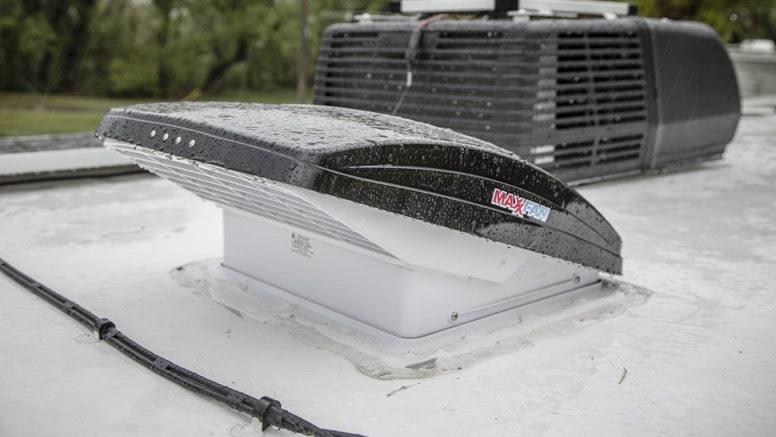
1. ODOR RELIEF
Whether you’re living in your RV full-time, or you’re taking a few extended trips each year, there’s bound to be a slow build of odors. Between laundry, seat sweat, pets (if you bring them along), you’re bound to build up a collection of unique scents that don’t meld well together.
While a deep clean is going to be the only way to remove the source of the odors, airborne smells can be extracted with your vent fan. (This includes the bathroom and toilet scents that may impede your driving due to distractions.)
2. EXCESSIVE HEAT RELIEF
You’re driving across the continental United States, and you run into a slew of varying climates. You’re not acclimated to Arizona’s killer heat, or the humidity of the sunshine state – another chance for your RV fan to shine.
While it’s not an AC, pulling warm, stale, and sometimes humid air from out of your cabin can help with some serious relief from the heat.
3. AIRFLOWS AND VENTILATION
Air gets stale, the ride gets to feeling a bit musty. Getting proper airflow helps with numerous things that affect your air quality, things you may not even be aware of.
Every time you use hot water on the dishes, someone takes a shower, you use an airborne chemical (like air or fabric fresheners), you’re adding humidity and other things into your air quality.
Ventilation is key to ensuring you can breathe easy for the entire trip.
RV Fan Vs AC
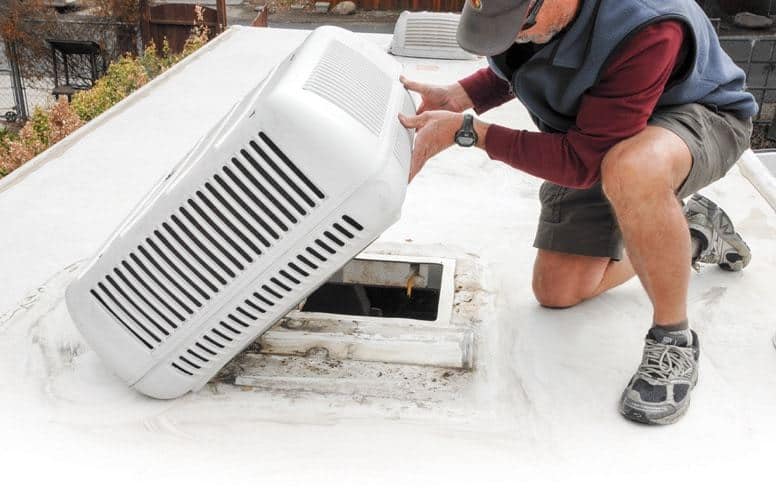
Have an AC versus an RV vent with the fan are two very separate things.
Here are a few key bullet points separating the two:
- An AC cools the air by conditioning hot air from outside or using air that’s already inside your cabin. A fan does not condition the air.
- Your RV vent with a fan does two features that an AC doesn’t; sucks the air out of the cabin, and also gently blows filtered air inside for a bit of relief from the heat/ventilation, without making it much colder.
- An AC unit can either come with the RV or potentially comes portable and requires additional floor space be taken up. A vent/fan combo is going to be affixed to your RV, eliminating additional storage problems.
- RV vent with fan models are ventilated through their access point. With an AC (if you have an older RV, it’ll be cheaper to buy a portable one), you have to find an area to stick the hose extension. It turns into a fiasco.
WHY IS AN RV FAN BETTER THAN AN AC?
If you want to run a load of electricity while battling the heat instead of defeating it, you’d want an AC.
If, however, you want a solution that’s more immediate with even, widespread effects, you’ll be going team fan all the way.
Fans with dual function (blow in, blow out) can provide some relief from the heat with a gentle breeze, but most importantly, they suck the hot, stale air out of your cabin and release it above your RV.
Instead of releasing cold air to combat the heat, which is a never-ending struggle, you can suck all the heat out of the cabin instead.
RV vent fans are superb for saving space, providing comfort, relief, and removing odors from your cabin.
An AC is going to blow cold air right over those issues, and only increase the humidity in your RV (to drastic levels), whereas your fan will actually eliminate humidity and moisture.
WHY YOU SHOULD HAVE BOTH AC AND ROOF VENTILATION
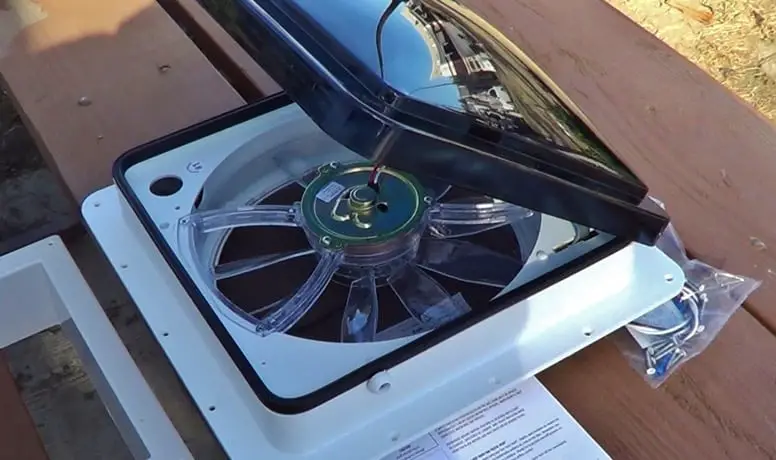
We’re not demonizing RV AC units, we’re simply stating that they each hold their own unique purpose.
RV vent fans offer far more benefits, but they don’t do the one main thing that an AC unit does – chill the air. Depending on how well you can adjust to the heat and how important comfort is, you may want to double-up and get both.
You can:
- Run your vent fan on blow-in mode while the AC is running. You’ll draw a lo9t of amperage, but this will push the cold air into circulation easier.
- Use the vent fan to pull out the humid, sticky air before running the AC. You’ll get a quicker chill and less fog/moisture on your windows.
Planning on living in your RV full-time or taking week-long trips?
Hotels aren’t for you, but that doesn’t mean their accommodations can’t be available to you.
A quality AC, especially if you can find a day rental electricity hook-up, can provide serious comfort on top of your fan.
When To Buy A Vent/Fan Combo And When To Just Replace The Fan
One aspect of this decision rests on availability.
You don’t want to kill yourself looking for new parts for your older RV vent or fan. Most models last for 2-3 years of use if you’re full-timing it, meaning you should be able to get a decade out of moderate to mild use every year.
In 10 years, there’s no telling if that model will still be available.
If you really like your fan and want to replace it, finding parts (and properly performing the work to ensure it’s kept under warranty) can be a bit of a chore.
Not to mention the cost associated with finding older parts. In most scenarios, this is something that’s going to be cheaper and less aggravating to simply replace in the long run. This is also a great excuse to get an RV vent fan upgrade.
OEM Fan Vs Buying A New One
When available, it always appears best to get an original part.
That may be true for internal components crucial to your engine function, electrical items, etc., but aftermarket RV vent fan replacements are actually a sound and solid choice.
OEM fan models are generally going to come with a higher sticker price – they’re limited in which RV models they can go into, sizing issues, and the like.
With aftermarket models, they contour to the average shapes and sizes of spaces for vent fans to accommodate to more models and RV owners. They can charge a lower cost because they don’t come with crazy overhead.
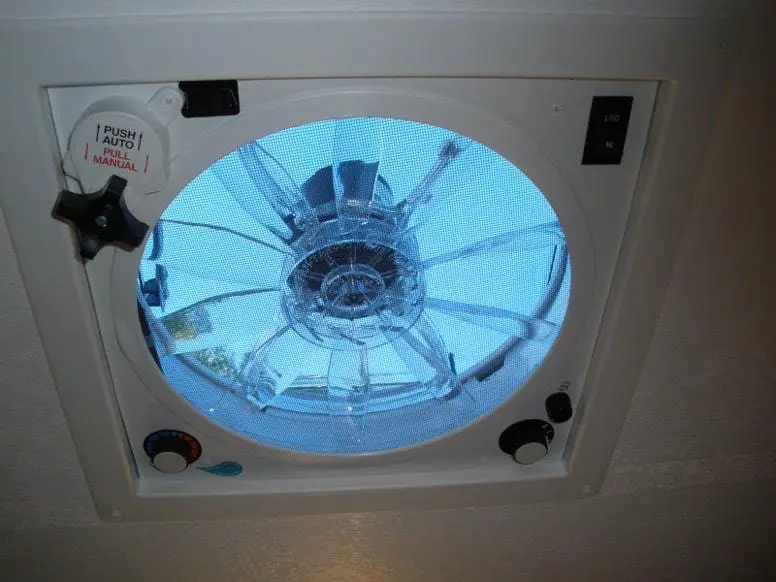
But how does it match on quality?
Since they’re competing with the models that are fitted to your RV and its specific dimensions, they have to bring immeasurable quality, or else they don’t have a market at all. That’s one of the beautiful things about aftermarket parts; they have to compete against the well-established companies.
Another perk to buying aftermarket is the promise that you’re getting newer energy efficiency details, as well as updated models.
You won’t have to hunt down an RV vent fan model that’s ten years old or more, (at which point, the price would have climbed even higher as they’re most likely out of production).
Saving money, companies that fight against one another for your favor, and updated efficiency. We’d recommend going aftermarket all the way.
OEM Fan Drawbacks
Some of the reasons an OEM fan is going to weigh you down may be shocking.
If you’ve been using the original fan for quite some time, you may not even realize these issues until you take a step back, or until after you install a newer aftermarket model.
LACK OF CFM
If you’re not familiar with the term, CFM means cubic feet of air per minute, and essentially sums up how much air can be moved or removed from your cabin in one minute’s time, multiplied by your overall space.
The higher your CFM, the quicker the results. However, there’s a severe lack of proper CFM on OEM models. The main selling point is the fact that they’re original parts, and the benefits don’t really surpass that.
NO EXTRA FEATURES
Everyone loves extra features, especially when you don’t have to pay out of the nose to get them. OEM fans are just that – fans, sometimes with vents, but never anything more.
NOISE
One way that aftermarket dealers are really working to get RV lovers to grab their fans instead of OEM parts rests in the noise level. OEM fans are meant to be functional and are never the focal point of your purchase.
When you go in for a new RV, you worry about the main things, such as how it runs, is there any floor rot, and the list goes on. The vent/fan is an afterthought.
OEM fans are just simply too loud.
They were never designed to be quiet, they were merely meant to work. When you’re on the road for quite some time, you’ll either be able to tune it out (while suffering in the heat), or it’ll drive you mad. Aftermarket models make it a primary goal to make as little noise as possible.
What To Look For When Buying A New RV Vent Fan

There’s a misconception among vent fans – there’s a lot more going on than you’d think.
Getting a new fan is going to cost a little bit; here are the key features to look for to ensure you’re getting the right RV vent fan replacement for you:
CFM
We talked about this briefly earlier. The higher the CFM, the quicker heat, and humidity get pulled from your cabin. Comfort shouldn’t have to wait.
AMPERAGE DRAW
Amps are one of the many aspects of defining electricity use. Amperage is a sign of how much energy you’re utilizing on a consistent basis to keep an electronic operational. Think of it as the cost to run your fan.
RUNTIME ON RV BATTERY
We can’t tell you what battery you have in your RV, but with a quick glance at your owner’s manual, you’ll be able to tell. On average, an RV vent fan will run for 72 hours before it toasts the battery.
There are a lot of factors to consider, including how many amps per hour your vent fan uses, your battery, and what speed/setting you have your fan on.
MANUAL VS AUTOMATIC LID OPENING
Taking a step back and popping the lid open manually isn’t that much of a bother. Automatic makes your life a little bit easier, but don’t break your budget over it.
EXTRA FEATURES (RAIN SENSORS, THERMOSTAT, SPEED VARIATION)
Little tidbits such as multiple speeds for the fan (which saves on your energy consumption) to rain sensors and a thermostat all make your vent/fan combo a little more useful and a whole lot better.
If you’re full-timing in the RV, these extra bits are going to come in handy more often than you might realize.
INTENDED USE
With anything in life, the more you use it, the quicker you wear it down. If you’re planning on going full-time, you’ll need a more durable RV vent fan . If you plan on leisurely vacations once or twice a year, you can opt for less expensive options.
Your intended use determines wear-and-tear.
ATTENTION PET OWNERS
If you’re planning on bringing Fido along, you’ll need a decent fan that can run stationary while you’re away. Your furry friends need ventilation, especially if you’re traveling in summer or in a hotter climate.
Ensure they have what they need when they leave, double their water, and make sure that the fan is running to keep the place as cool as possible.
Installation Tips
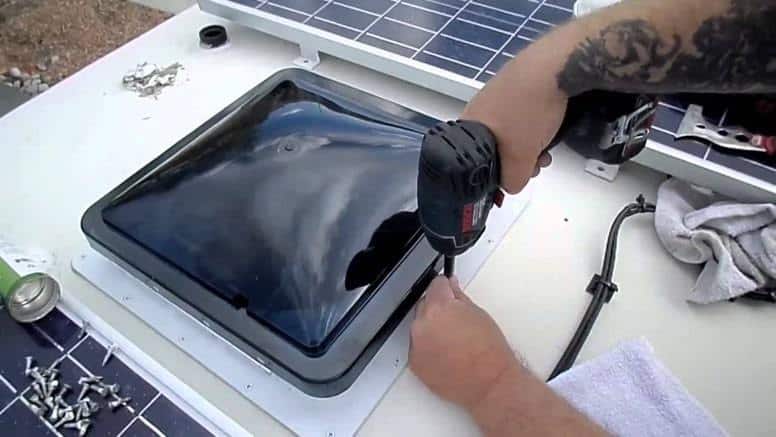
Never installed one on your own before? No worries – we’ve got you covered.
Here are some tips, tricks, and instructions from experts who have done this more than once before.
- Look out for the lid size when you go to purchase. Your owner’s manual may have some information (not all do) regarding your current OEM vent size. If not, bust out the measuring tape. A standard lid is 14×14”, so if that’s the number you found in your manual or gathered yourself, you’re on the right track.
- When it comes to the thickness of your roof, you may run into issues. Measure this one yourself through your current vent or the hole where your vent was, in order to get an accurate number. Our top pick, the Fan-Tastic 7350, comes with a 14x14x12” diameter, meaning you have a foot of space to work with. If your roof is thicker than that, you’ll hit a snag. Be certain to measure this before committing to a purchase.
- When removing your OEM vent, you’re going to see a line of caulking along the edges. The older and more weather your RV is, the harder it’ll be to scrape this stuff off. Assuming that you have disconnected all electrical wires, begin using a putty knife to chip away at the old caulking. Once that’s finished, you’ll need to enter the cabin to begin removing the screws holding the vent in from the underside. Once the last few screws are out, you should be good to simply remove the fan.
- We’ve seen some YouTube videos and guides that explain how to wall mount your vent fan. Let’s stop it right there – you should never put it into your wall. Firstly, it can, and usually does, void the warranty. The intended use is for your roof, not the walls. Second, you’ll suffer efficiency loss – it’s intended to drag air upward, not horizontally. Lastly, you may run into issues with the law. Certain counties and states see a sideways RV vent fan as a safety hazard for other drivers and pedestrians in thickly settled areas (and they would be right).
- When you want to attach a new vent fan to an existing opening, assuming you’ve removed the old vent and sanded the space down, you’re actually going to start from the interior. If you have someone around as a second set of hands, bring them along for the ride. You’ll need to mount your vent fan via screw holes before we take to the roof. Once you’ve affixed it as best you can, we need to step outside and climb up. This is where you’ll specifically use weatherproof, outdoor caulking that’s intended to adverse weather conditions. You don’t need to worry about sanding when you’re done, just allow the appropriate time (whatever it says on the caulking brand you purchased) for everything to dry before hitting the open road.
- This is generally everyone’s least-favorite part: wiring. The wiring procedure is relatively simple, so shake off the nerves before you take to it. The simplest way to handle this is to pay close attention to, and perhaps even take photos of, the way that your wiring was set up beforehand. For the most part, you’ll run into the same connection and be able to mimic the previous method. In very rare instances, you may need to splice and “tee” off of neighboring lighting wires.
How To Clean Your Vent Fan
It won’t do you much good if it’s dirty.
Your vent/fan combo is going to accumulate grime the more it’s used, so if you’re full-timing it, you’re going to want to attend to this at least once every two weeks. For a deep clean, twice a year. Let’s run through both options.
QUICK CLEAN
When you go through your RV, you have a small amount of space to clean, so you want to get it done as quickly as possible. Using a vacuum hose with an appropriate upholstery brush, gently graze it over the screen beneath your blades to remove accumulated dust.
If you have certain Fan-Tastic models, you’ll be able to pop the screen out without needing screws.
Take a damp paper towel, and run it along the top and bottom of each blade.
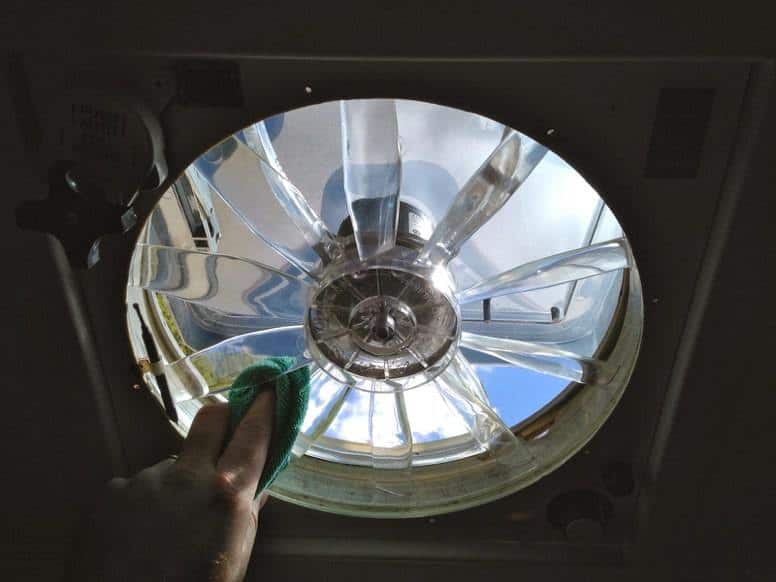
You’ll have a gray rag by the end, but you can quickly toss it out, put the screen back on, and go on about your day. This process generally takes 2-3 minutes.
THE DEEP CLEAN
This is where things get a bit more involved. Depending on your model, you may have to disassemble most of your fan.
This process, as a heads-up, is going to take you roughly 20-25 minutes. You’ll need a few paper towels, either water or window cleaner spray (either one does the same trick, it’s just about preference), and a small bristle brush for hard-to-reach areas.
Let’s get started.
Begin by removing your screen. Normally, we would vacuum this, but instead, you’re going to run water through it and let it air dry. You’ll be just beneath your exposed blades. Take a paper towel and grab all the dust you possibly can, while getting the top and bottom of each blade.
From here, you’ll notice that along the ring, there are a few bits of dust which are a real pain to get to. It’s time to use that bristle brush, and gently remove any and all dust that you can’t reach with a paper towel. This is going to fall to the floor beneath you, so it’s best to wait until the end to vacuum.
This process will be a bit lengthy, but your vent fan will look brand new when you’re done. To be thorough, you can take to the roof and examine any additional accumulation of dust and/or dirt, though it isn’t required to get a deep clean on the working parts. Replace the screen, and you’re done.
QUICK SAFETY TIP WHEN CLEANING
Whichever method you’re using, let your entire traveling party know that you’ll be cleaning your vent fan. The last thing you want is someone coming in and flipping a switch when you’ve got your hands on the blades.
Tell Us About Your Experience
Have you owned one of these models in the past? Installed one for a friend?
Let us know all about your experiences in the comments below.
If you haven’t already picked up your new vent/fan combo, be sure to scroll back up the page and make your selection.



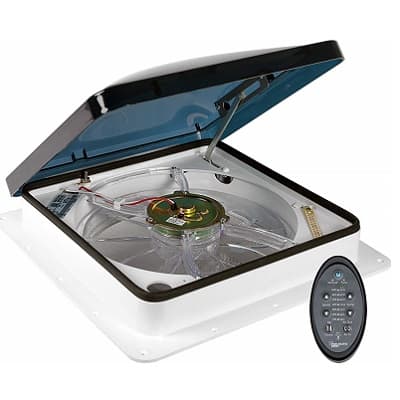
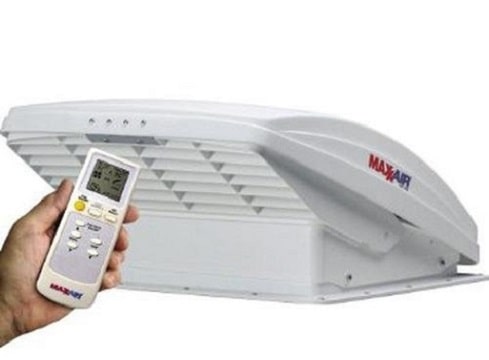
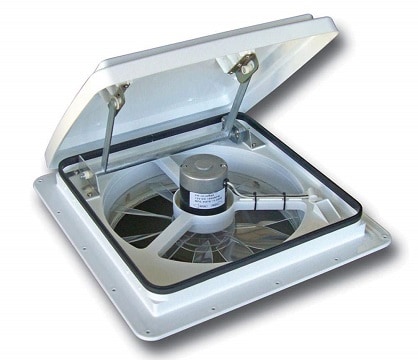
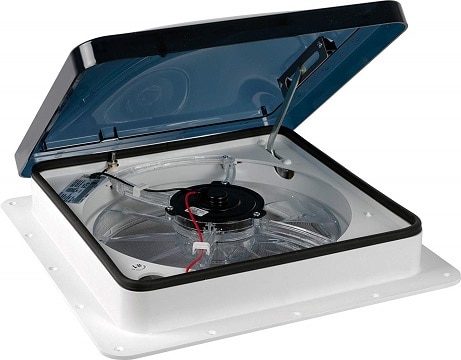
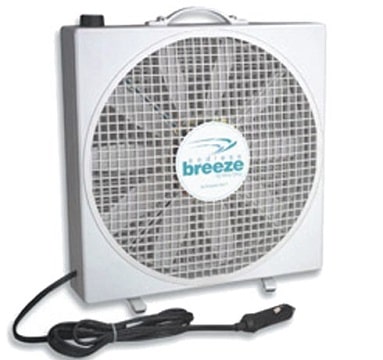
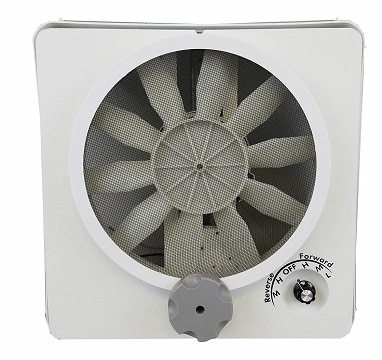



Wow, what a great write-up. Well researched, unbiased, and very comprehensive. As a full-time RV’er for 8 years, I can’t believe I’ve never stumbled across your web site. Lots of very helpful information. Consider yourself “bookmarked”, and keep up the great writing.
As for the fans, I bought the MaxxAire 00-04000k model last fall and have been very happy with it. I’m thinking about buying a second one. Two points to consider: First, while their web site claims a two-year limited warranty, I’ve read many comments about frustrations in dealing with customer service. Second, this model has two plastic tabs built into the frame which will prevent you from using any vent cover other than their own FannMate model, which runs about $55 at this writing. The tabs are supposed to make installation easier, but I suspect they have other motivations. (Amazon’s photos do not show the tabs!) All in all, ten speeds, reversible with a thermostat for around a buck-and-a-half? Hard to beat.
Glad to hear that, Joe! Thanks for the stopping by.
I am looking for a 12 volt very high quality ,extremely quiet yet moves 900cfm or more roof fan. it must be able to run during a pacific north west winter downpour with out water coming in , white in colour ,available in Canada installed on a ford transit 2500 van roof.
I have seen the ones in your column and to be frank the only one that looks up to the task ,barely, is the max air one.
I am very disappointed in the offerings from the RV industry to be quite honest…
is there anything NOT made of plastic as in metal -made in USA ,Germany or some place that has high construction standards
Great review! I am also using Fan-Tastic Vent 801200 3-Speed RV Roof Vent. This is the 3rd Fantastic Fan that I have ordered, and I have been very satisfies with them all. First of all, and most important top me, is the performance. This fan moves a lot of air, and does it very efficiently. I rarely turn it own above the lowest setting because it moves so much air. I also use it to exhaust smoke and heat generated when cooking. It does a great job of that also. I love this fan, and would definitely recommend it to a friend.